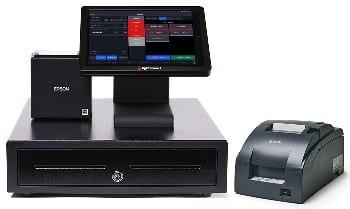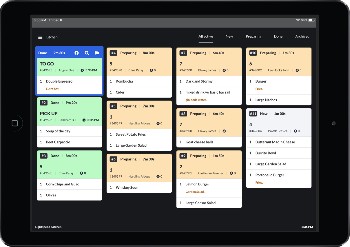The best restaurant point-of-sale (POS) system for your restaurant depends on your budget and hardware and software needs. To help you make the best decision, I compared dozens of popular restaurant POS systems’ pricing, general and advanced features, and ease of use. Our readers have requested user-friendly restaurant POS systems with comprehensive baseline features, so that’s what I prioritized in these rankings.
Based on my research—and the experience of other Fit Small Business POS experts—these are our top picks for the best restaurant POS systems for 2024:
- Toast: Best overall restaurant POS for restaurants of all types
- SpotOn: Best for multi-location restaurants
- Lightspeed Restaurant: Best for reporting and analytics
- Revel Systems: Best iPad POS for Multi-location Restaurants
- Lavu: Best for switching from cash-only operations
- Oracle MICROS Simphony: Best for flexible payment processing
- Square for Restaurants: Best free restaurant POS
- TouchBistro: Best for ease of use
Why You Can Trust Fit Small Business Rankings
Our best restaurant POS system rankings are based on my personal experience using point-of-sale systems in all types of restaurants for more than 14 years. To get real-world experience with new systems, I schedule detailed demos, use free trials, and talk to restaurant owners who use these systems.
We update our restaurant POS rankings multiple times a year, so these rankings also reflect the experience of other Fit Small Business POS experts. Our rankings are editorially independent, read our full editorial policy for more details.
Best Restaurant POS Systems Compared
Our Rating | Price | Processing Rate | Standout Features | |
|---|---|---|---|---|
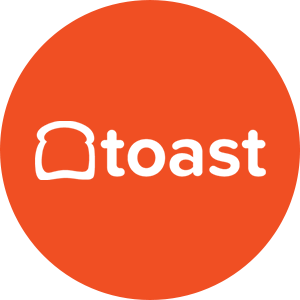 | 4.27 out of 5 | $0 to $165+ | From 2.49% + 15 cents | Workforce management |
4.23 out of 5 | $0 to $135+ | From 1.99% + $0.25* | Mobile ordering | |
4.00 out of 5 | $69 to $399+ | From 2.6% + 10 cents | High-level analytics | |
4.08 out of 5 | Custom-quoted | Varies by processor | Multilocation management | |
4.04 out of 5 | $59 to $289+ | Custom-quoted | Cash discounting | |
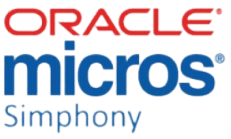 | 4.04 out of 5 | $55 to $79+ | Varies by processor | Flexible Payment processing |
3.86 out of 5 | $0 to $60+ | From 2.6% + $0.10 | Free and Pay-as-You-Go options | |
3.80 out of 5 | $69+ | Custom-quoted | Ease of Use | |
Toast: Best Overall Restaurant POS

Pros
- Operates on industry-grade hardware
- Baseline software subscription is $0 per month
- Tons of hardware peripherals
Cons
- Two-year contracts
- Locked into Toast for payment processing
- Must purchase Toast-built hardware
Why we like it
I’ve used Toast in multiple restaurants and seen it grow from an industry disruptor to one of the most popular restaurant POS systems available. Toast combines industry-grade hardware with $0 upfront cost, and supports built-in tools for everything from employee onboarding to online ordering and marketing to catering management. With customizable add-ons, you can get self-service kiosks, drive-thru management, and the best workforce management tools available in a restaurant POS.
Toast earned the top score because it offers so many features—more than we can list here, so read the full review below for a granular view. It also integrates with virtually every third party restaurant software you’d ever want, and it gets solid user reviews— averaging 4.2 out of 5 on most review sites at the time of publication.
Quick Start Bundle | Core | Growth | Custom | |
|---|---|---|---|---|
Monthly Software Fees | $0 (for up to 2 terminals) | $69 | $165 | Custom-quoted |
Processing Fees |
| |||
Countertop Terminal Starter Kit | Self-service Kiosk | Handheld Terminal Starter Kit |
|---|---|---|
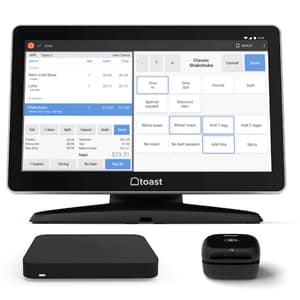 | 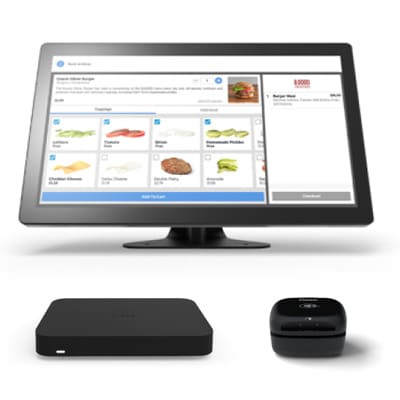 | 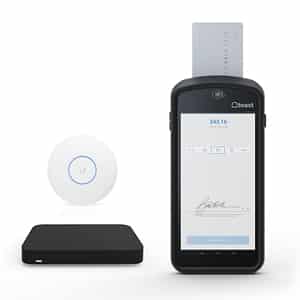 |
Pay upfront: $875 + $69 per month Or Pay-As-You-Go: $0 and 2.99% + 15 cents per in person transaction | Pay upfront: $1,009 + $99 per month Or Pay-as-you-Go: $0 and 2.99% + 15 cents per in-person transaction | Pay upfront: $627 + $69 per month Or Pay-as-You-Go: $0 and 2.99% + 15 cents per in-person transaction |
Countertop Terminal, Toast Tap card reader, Router | Touch-screen kiosk with router and card reader | Toast Go 2 order and payment device, Wireless Access Point, Router |
If you want handheld tablets for tableside ordering, dynamic kitchen display system (KDS) screens, and self-service kiosks in your POS package, Toast has you covered. Toast’s self-service kiosk and KDS are our top recommendations for those restaurant tools.
- Online Ordering and Delivery
Toast offers built-in online ordering as part of the Core and Growth packages (Starter Kit and Point of Sale users can add it for $75 per month). This module fully integrates with your loyalty program, and the menu syncs with your inventory. Toast is among our top picks for online ordering systems. - Marketing and Loyalty
Create email messages to target specific customer types and send them directly from the POS. Toast supports points-based rewards and includes built-in customer feedback tools, so you’ll catch disappointed guests before they complain on Yelp. - Workforce Management
Build staff schedules and block early clock-ins. Onboard new employees entirely digitally, keep their new hire paperwork in a central location, and sync that information immediately with your payroll system. Toast can also manage tip pooling arrangements. - Reservations
Toast recently added Toast Tables, a fully integrated, comprehensive reservation system that operates on iOS and Android tablets. Customers can add themselves to your waitlist via your Google listing. Plus, you’ll get detailed guest profiles with two-way messaging, order status synced with your POS, and an automated server roster that ensures fair section seating. - Catering Management: Toast has the strongest built-in features for managing catering and special event leads, contracts, and banquet event orders (BEOs). If you have a catering and events segment or plan to in the future, Toast can centralize all of your business in a single platform.
SpotOn: Best Multi-Location Restaurant POS

Pros
- Highly customizable
- Excellent handheld terminals for curbside and mobile service
- Excellent reservation and team management tools
- No long-term contract
Cons
- Set up can take a couple of weeks
- Locked into SpotOn Payments
- Requires hardware purchases
Why we like it
SpotOn is a cloud-based POS system with a laser focus on the most cutting-edge POS technology. So it’s no wonder that SpotOn’s contactless and mobile ordering tools are incredibly strong. SpotOn recently rolled out SpotOn Teamwork, a staff scheduling and management app (based on the former Dolce platform) so strong that it even integrates with competing POS systems (Toast, Square, Clover, Lightspeed, and Revel).
If you have a unique concept with unusual needs, you’ll love SpotOn’s customizability. SpotOn’s team custom builds your menu and order screens for you. This saves your administrative bandwidth (but can increase your installation lead time). A typical SpotOn installation takes a couple of weeks to complete. The only way SpotOn could have scored higher is if it supported multiple processors or operated on pre-owned hardware like iPads.
Quick start | Counter-service | Full-service | Customize Your Own | |
|---|---|---|---|---|
Monthly Software Fees | $0 (with higher processing fees) | $99 | $135 | Custom-quoted |
In-person Payment Processing | From 2.89% + $0.25* | From 1.99% + $0.25* | ||
Installation Fee | Remote guided installation is included free of charge | |||
*Rates are baseline for most cards; rates may be higher for rewards cards or AMEX. Processing minimums may apply to Quick Start plans.
Station POS | Counter POS | Kitchen Display System Screen |
|---|---|---|
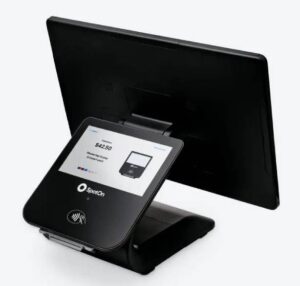 | 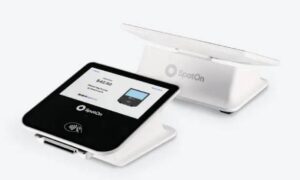 | 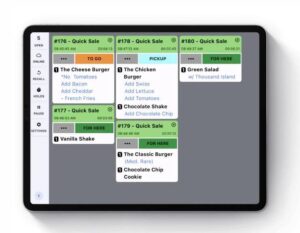 |
$750 | $850 | $600 |
Flexible countertop terminal with built-in card reader and optional customer-facing display | Low profile countertop terminal with satellite customer facing touch screen | Touch-screen KDS screen |
- SpotOn Teamwork
SpotOn acquired staff management tool Dolce in 2021. In 2023, they rebranded this excellent employee scheduling and management app as SpotOn Teamwork. This app enables smart-scheduling to save you admin time (up to 20 hours a week), and helps you stick to your labor budgets. You can also track staff availability, manage shift swaps, and get alerts for local labor regulations like California’s Meal Break Penalties. The only competing system that even comes close to this level of staff management is Toast.
- Mobile Ordering
Your customers can place group orders and split the bill multiple ways directly from their smartphones. SpotOn also integrates with Ordr, an app that allows event attendees to order food to be delivered to their seats in arenas and stadiums. An integrated order-ready display screen shows takeout customers and delivery drivers exactly when their order is ready. - Contactless Payments
SpotOn users can accept NFC and mobile wallet payments onsite and online through SpotOn’s integrated mobile ordering system. Processing rates are lower than competitors’ published rates (starting at 1.99% + 20 cents for in-person payments), and custom-rate quotes are available. Handheld terminals operate via Wi-Fi and 4G connections, so you’ll never go offline. - Automated Upsells and Discounts
Your mobile and on-site ordering modules can automatically suggest items that are popular pairings or apply discounts when an order meets the promotional criteria. - Reservations and Bookings
SpotOn’s built-in reservation module is the most complex of the systems on this list. Beyond simple reservations and waitlists, it includes “experience” bookings for special events like themed parties or add-ons like to-go meals. The system can also accept deposits, so you can easily sell ticket-style events with little administrative hassle.
Lightspeed Restaurant: Best for Reporting & Analytics

Pros
- Robust, automated inventory
- Integrates with multiple payment processors
- Designed for speedy order taking
Cons
- No free trial or free baseline subscription
- No driver management
- Advanced inventory costs extra
Why we like it
Lightspeed Restaurant is a mobile-first, cloud-based iPad restaurant POS with a streamlined user interface. I’ve driven demo versions of this software and talked to small business owners that love this user-friendly POS. Lightspeed Restaurant always had user-friendly—if limited—reporting in its POS. But it recently expanded its restaurant reporting features by a mile when it acquired Upserve (formerly Breadcrumb) in 2020. I loved the intuitive analytics, reporting and inventory tools when they were part of Upserve, and I love them just as much on the Lightspeed platform.
Lightspeed Restaurant supports lots of customized reports, but also offers automated reports that show you detailed customer behavior and supports advanced, automated inventory. These tiers are the priciest, but consolidating these advanced features in pricier subscriptions ensures that smaller restaurants don’t pay for tools they likely won’t use. Lightspeed reporting and inventory tools earned it a spot on our ranking of the top restaurant inventory management software.
Starter | Essential | Premium | Enterprise | |
|---|---|---|---|---|
Monthly Software Fees | $69 | $189 | $399 | Custom-quoted |
Lightspeed Payments Processing Fees |
| |||
- Advanced Reporting
Lightspeed used to require an Essential or Premium subscription to access the excellent reporting tools, but they now include them at every subscription level. With Lightspeed’s Advanced Insights, your reporting is tied to your Lightspeed Payments data, so you get a lot of automated analysis on customer purchasing and attendance behavior. You’ll also get detailed menu reporting with automated recommendations for which dishes need more promotion and which ones you should drop from your menu. Staff productivity and business overview reports are also excellent. - Quick Order Mode
Lightspeed Restaurant has a quick order setting that combines ordering and payment options on a single screen. This speeds orders in a quick service environment. - Automated Vendor Management
Lightspeed’s built-in Advanced Inventory tracks your inventory at the ingredient level. A smartphone counting app turns any smartphone camera into a barcode scanner to check in deliveries and count inventory quickly. Reports calculate recipe costs and track price fluctuations from your vendors. The “1-click” reordering function allows you to place orders with multiple vendors with the click of a single button. - Flexible Payments
You can choose to use the fully built-in Lightspeed Payments (which will increase your POS system’s reporting power), or shop for processing rates. Lightspeed also integrates with Cayan, BridgePay, and Worldpay. Lightspeed may charge a higher monthly fee for using a third-party processor, though, so be sure to contact them for a custom quote.
Revel: Best iPad Multi-location POS

Pros
- Dynamic menu modifiers handle complex orders
- Centralized multilocation reporting
- Multiple options for payment processing
Cons
- 3-year contract
- Requires custom quote
- Only cost-effective for companies with 5+ locations
Why we like it
Revel Systems is a feature-rich iPad restaurant POS that combines cloud POS flexibility with a local POS network’s stability. Revel includes centralized multilocation reporting and supports multiple payment processors. Revel also outscored the others on this list for general and niche POS functions. Though the custom-quote pricing and long-term commitment (three years) make Revel a better fit for multilocation restaurant groups than for independent mom-and-pops.
I’ve used this POS in a bar and restaurant setting, and I can tell you that the back office dashboard has a bit of a learning curve, mostly because the system is so customizable. Revel includes 24/7 customer support and a deep online knowledge base to help you. The downsides are the upfront price and contract. But you might be able to recoup some costs with lower payment transaction fees; Revel integrates with several processors so restaurant groups can shop for the best rates.
Monthly Software Fees | Custom-quoted (previously $99 per month with a 2-terminal minimum) |
Implementation Fee | Custom-quoted (previously listed at $674 minimum) |
Payment Processing | Custom-quoted; choose from Revel Advantage, First Data, Heartland, TSYS, Worldpay, Chase Paymentech, Elavon |
Apple iPad | Apple iPad mini | Revel C-stand | Revel L-Stand |
|---|---|---|---|
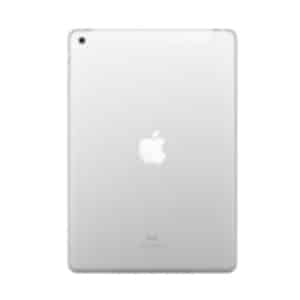 | 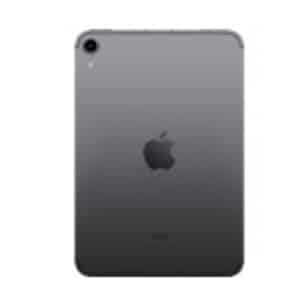 | 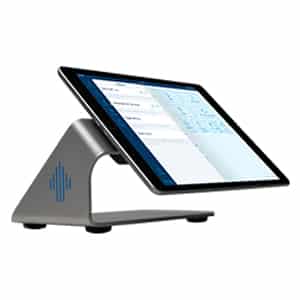 | 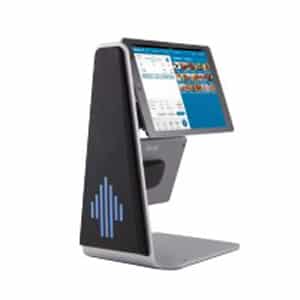 |
10.2-inch to 12.9-inch display for POS, KDS, and self-service kiosk screens | 8.3-inch display, ideal for in-store and tableside orders and payments or customer-facing displays | Low-profile iPad stand for POS terminals or self-service kiosks | iPad terminal stand with customer-facing display |
- Strong Offline Functionality
Your Revel Systems terminals are networked together on-site. So, if you lose your internet connection, the system still sends orders to your kitchen and processes payments. - Comprehensive Baseline Features
The baseline Revel Systems POS includes functions for employee scheduling, customer management, and inventory management. As with Toast, you can preauthorize bar tabs, and create custom floorplans and menu screens. - Built-in Online Ordering and Delivery
Like Toast, Revel Systems has a fully integrated online ordering and delivery module—it made our ranking of top food delivery software. Revel’s tools are slightly more robust than Toast’s, featuring much more detailed driver management reports alongside the maps-based driver dispatch tools. Online ordering screens are easy for customers to navigate. - Multilocation Tools
Revel hosts centralized reporting and menu controls. At the enterprise level, you can also leverage open application programming interface (API) to build custom integrations through all of your restaurant locations.
Lavu: Best for Switching From Cash Only

Pros
- Mid-priced; cost-effective for small restaurants
- Automated cash discounting tools
- Can use hardware you already own
Cons
- Customizations and add-ons can get pricey
- Some features are less robust than competitors
- Reporting is not robust
Why we like it
Lavu is a popular, mid-priced iPad restaurant POS system. This software is so accessible that you can download it from the Apple App Store and start taking orders in a couple of hours. Lavu’s niche is offering good POS functions at a reasonable cost. It also supports a setting for automated cash-discounting, enabling restaurants that cannot afford card processing fees to accept card payments at no additional cost by passing processing fees on to customers.
This POS includes ingredient-level inventory in the baseline POS, which is great, but the Lavu module is not as robust as those from competitors like Lightspeed and Revel Systems. If you don’t plan to use inventory tracking, this won’t be a drawback for you, though. Several Lavu user reviews mention limited and glitchy reporting, so if reporting and analytics are key features for you, Lavu may not be the best fit, though.
Starter | Growth | Optimize | |
|---|---|---|---|
Monthly Software fee (with enrollment in Lavu Pay with Cash discounting) | $59 | $129 | $279 |
Monthly Software fee (with enrollment in Lavu Pay) | $69 | $139 | $289 |
Installation fee | $0 | ||
Windfall iPad stand | Vault iPad Stand | Customer-facing display |
|---|---|---|
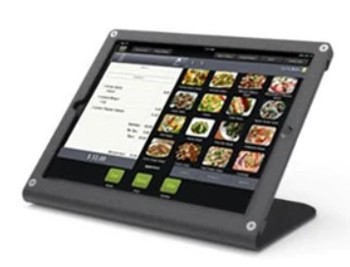 | 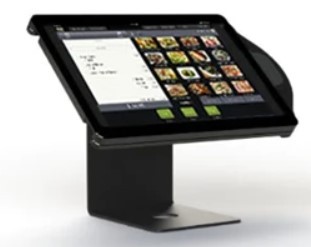 |  |
$189 | $259 | $109 |
Small footprint countertop iPad stand | Handheld order and payment device | Countertop mounted self-service kiosk |
- Cash Discount Option
Lavu’s Cash Discount feature enables restaurants to charge different prices for customers that pay with cash vs credit cards. This offsets the cost of credit and debit card transaction fees, while handily side-stepping laws in 11 states that prohibit passing processing fees onto customers. - Comprehensive Baseline POS
Lavu’s baseline POS includes all the basic check splitting, payment splitting, and employee permission features that you’d expect in a restaurant POS. Ingredient-level inventory is included in the entry-level POS as are insightful touches like tip pool tracking and built-in employee scheduling tools. - Nutritional Information Display
Lavu prompts you to add nutritional information to your menu items in the POS. This enables the system to display this information seamlessly to customers on the Lavu self-order kiosk, saving time and customer questions. You can also add high-resolution menu images to guide your employees and customers quickly through order screens. - Robust Integrations
If you need a software tool that the Lavu POS lacks, you can likely find an integration for it. Lavu integrates with more than 100 third-party tools, covering everything from accounting to specialized inventory and third-party delivery aggregators. For payments, Lavu integrates with Worldpay, BridgePay, Heartland, PayPal, and Square.
Oracle MICROS Simphony: Best for Payment Processing

Pros
- Detailed cash tracking tools
- Oracle Payments has no long-term contract
- Hardware starts at $1 per terminal
Cons
- Few third-party integrations
- Cannot be self-installed
- Hardware, installation, and payment processing require custom quotes
Why we like it
Oracle’s MICROS Simphony is the cloud-based version of the legacy MICROS POS that has supported restaurants for decades; so the software is battle-tested. The built-in Oracle Payments has no long-term contract; if you don’t want to use Oracle Payments, the system integrates with Adyen or Elavon. Simphony has the most advanced cash tracking tools of any system on this list. You can set high till alerts, track paid-in and paid-outs, and even log petty cash transactions.
Like Revel Systems, Simphony has a bit of a managerial learning curve. And—based on our experience using this system in multiple restaurants—we can tell you that how well your management team configures your Simphony system has a huge impact on how well the system works. If you don’t have the time to learn to use MICROS Simphony, you’re better off spending your money on a foolproof POS like Toast or TouchBistro.
Essentials | Plus | Single Tenant | |
|---|---|---|---|
Monthly Software fees | $55 | $75 | Custom-quoted |
Installation | Custom-quoted | ||
Payment processing | Varies by processor; choose from Oracle Cloud Payments, Ayden, or Elavon | ||
MICROS Compact Workstation 310 | MICROS Customer-facing display | Mobile 721 Tablet | Express Station 400 |
|---|---|---|---|
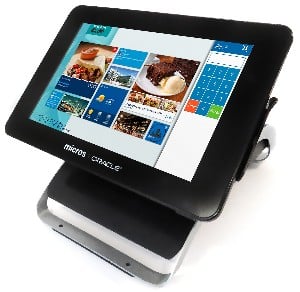 | 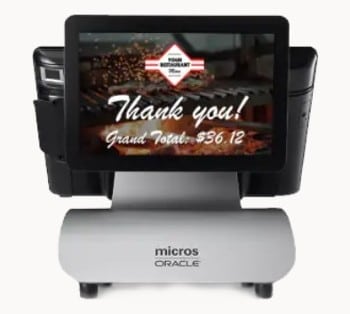 | 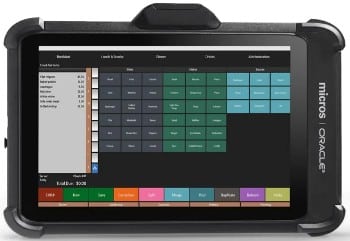 | 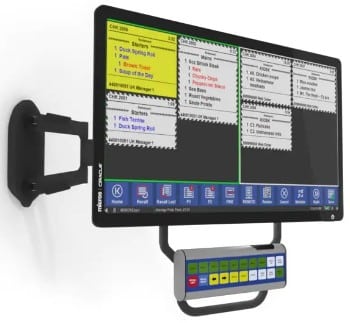 |
Small footprint countertop touch-screen terminal | Customer-facing display | Handheld order and payment device | 24” KDS screen with bump bar navigation |
- Payment Flexibility
Like Revel, Lightspeed, and TouchBistro, MICROS Simphony offers built-in payment processing and integrates with several payment processors. With Simphony, the built-in option is Oracle Payments Cloud Service, which, unlike most competitors, has absolutely no long-term contract. - Workforce Management
Like Toast and SpotOn, Simphony includes detailed team management, including employee scheduling and onboarding. It also manages time-off requests with a self-serve employee app. - Offline Functionality
Simphony’s offline functionality is stronger than any system on this list. Simphony is locally networked and backed up to the cloud. If you lose internet access, your workstations communicate with one another, storing payment and timekeeping information in a central, offline cache. If a workstation disconnects from other workstations, then payment and timekeeping data is stored in the terminal itself until a connection is restored. - Customized Speed Screens
Simphony is the king of conversational ordering. Customized speed screens for servers, cocktail servers, bartenders, and cashiers list the most relevant modifiers on a single screen, reducing button presses and screen switching.
Square for Restaurants: Best Free Restaurant POS

Pros
- Baseline POS subscription is free
- No long-term contracts
- Free online ordering site included
- Flat-rate payment processing with no chargeback fees
Cons
- Locked into Square for payment processing
- Reporting not as robust as competitors
- Ingredient-level inventory requires integration
Why we like it
Square for Restaurants is a cloud-based POS that runs on iPads and Square-designed hardware. The main thing that kept Square from scoring higher is that most of the customization options come at an extra cost, either in the form of additional Square modules (like Square Teams and Square Payroll), or third-party integrations (like MarketMan for ingredient-level inventory).
These extra costs are understandable, though, as Square for Restaurant’s baseline POS is completely free to use. Best of all, Square is the only system on this list that does not require any long-term contracts. I’ve installed this system in multiple food trucks and consulted with full service restaurants that use Square to manage in-house and online orders. It only takes a couple hours to create your Square and enter your menu items; you can get started processing orders the same day, and cancel or upgrade your subscription at any time without penalty. I love Square for Restaurants as an entry-level POS, and I’ve seen many restaurant-owning friends plan to use Square for the short term, only to love it so much that they keep it for years.
Free | Plus | Premium | |
|---|---|---|---|
Monthly Software Fees | $0 | $60 | Custom-quoted |
Installation Fee | $0 | ||
In-person Processing fees | 2.6% + $0.10 | ||
Online Processing Fees | 2.9% + $0.30 | ||
Square Stand | Square Terminal | Square Register | Square Restaurant POS Kit |
|---|---|---|---|
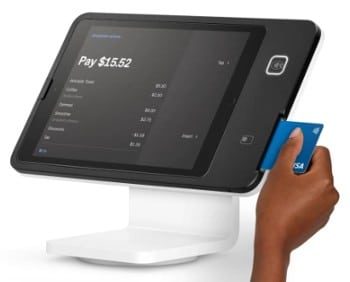 | 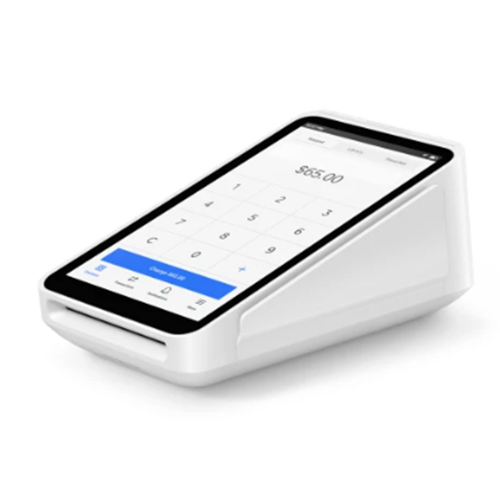 | 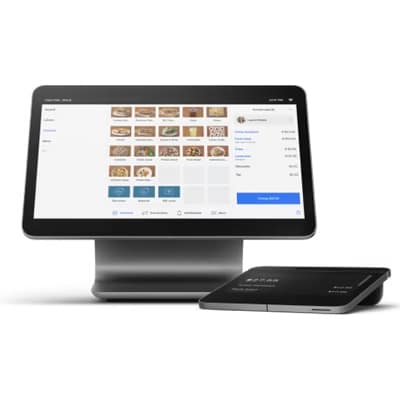 | 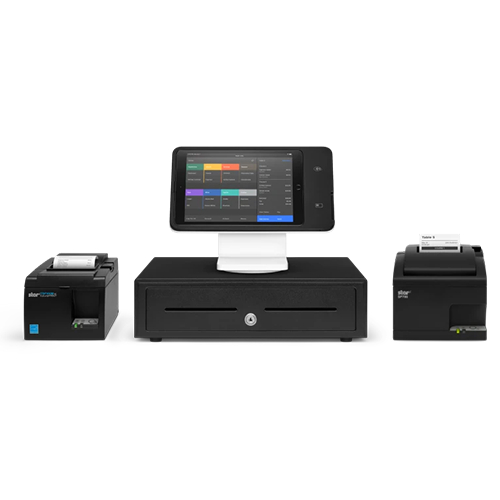 |
$149 or $14 per month for 12 months | $299 (or $27/ month for 12 months) | $799 or $39 per month for 24 months | $1,139 |
Countertop POS terminal with built-in tap and dip card reader | Handheld order and payment device | Low-profile iPad stand for POS terminals or self-service kiosks | Square Restaurant POS kit including Square stand, cash drawer, receipt printer, and kitchen printer |
- Free Baseline POS
Square for Restaurants’ baseline POS is free to use. It is best suited to counter service operations that don’t need to ring in orders by course or seat number. But these restaurants are frequently overlooked by higher-priced restaurant POS brands, so the free Square for Restaurants POS plan can be a lifesaver. - Transparent Pricing
Square for Restaurants clearly lists subscription prices, transaction fees, and hardware costs on its website. If you have a large-scale restaurant business and think your costs to use Square for Restaurants will be high, reach out to the Square sales team for a custom quote for software and payment processing. - No Long-term Contract
You can start with Square for Restaurants and cancel without penalties if it isn’t a fit for your business. - Flat rate processing
Initially, Square’s processing fees may seem higher than competitors like SpotOn, but Square’s processing is truly flat rate. You pay one fee that only varies by the payment method (in-person, online, card-not-present, etc.). You won’t pay extra for American Express or rewards cards, and Square won’t ever charge you a chargeback fee if a customer disputes a charge. - Integrated Square Ecosystem
You can add integrated online ordering via the free Square Online store and sync your employee time and tip data directly with Square Payroll. If you offer catering or sell foods to businesses that pay monthly, Square Invoices has the tools you need. All of these small business tools working together can save you hours of administrative time; especially if you are an owner-manager.
TouchBistro: Best for Ease of Use

Pros
- User-friendly, iOS-based user interface
- Affordable
- Known for speedy staff training
Cons
- Reporting has limitations
- Locked into TB Payments
- No free subscription or free trial
Why we like it
TouchBistro is an incredibly user-friendly cloud POS for restaurants. The system’s easy installation directly networks your iPad POS terminals to one another, so many TouchBistro users don’t need a separate back office computer. This POS operates on iOS devices and relies heavily on the iOS user interface. So, anyone who has operated an iPhone can operate TouchBistro’s POS and managerial dashboard.
Most teams find that new employees can learn TouchBistro in less than an hour, which is great in a restaurant that has high staff turnover. You can also perform most managerial tasks directly in the POS terminal, so there may be no need to use a back office computer. This system could have scored higher if the baseline POS included more functions (like loyalty and online ordering) or if the built-in inventory tools were more automated.
Monthly Software Fees | $69 per terminal monthly |
Installation | Custom-quoted |
Payment Processing | Custom-quoted |
Small Venue POS Kit | Large Venue POS Kit |
|---|---|
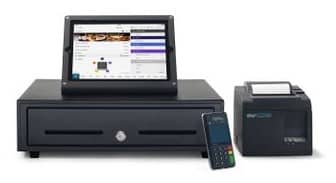 | 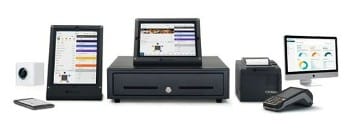 |
iPad, iPad stand, cash drawer, receipt printer, PIN-enabled mobile card reader | iPad, iPad stand, router, tableside tablet, back office computer, cash drawer, receipt printer, PIN-enabled mobile card reader |
- Incredible Ease of Use
TouchBistro uses the familiar iOS layout to intuitively guide you and your team—including managers—through all the POS features. - Transparent Software Pricing
TouchBistro lists nearly all of its software pricing publicly. So, while it is a good idea to get a custom quote, you won’t have to worry if you are getting a good deal; you can just check the TouchBistro website. Prices range from $25 per month for gift card functions up to $299 per month for built-in reservations. - Streamlined All-in-One POS
You can create custom floor plans and start tabs with a credit card swipe. TouchBistro tracks your employees’ hours and tips for payroll, supports image-based menus, and includes ingredient-level inventory in the baseline system. - Templatized Reporting
If report analysis is not your strong suit, you’ll love TouchBistro’s easy-to-read, visually dynamic reports. Most reports are formatted to include bar graphs and pie charts that show your restaurant’s performance at a glance, so you always know if your numbers tell you to increase your staff levels or drop a costly dish from your menu.
Methodology: How We Evaluated Restaurant POS Systems
My colleagues and I compared dozens of the most popular POS systems for restaurants based on essential restaurant functions like inventory management and online ordering, employee management, price, and ease of use. We also considered our personal experience and evaluations of each software.
Our readers told us that they prized ease of use and comprehensive features over other considerations. So our scoring system puts a lot of emphasis on ease of use and included features.
Click through the tabs below for our in-depth evaluation criteria:
15% of Overall Score
Independent restaurants operate with tight budgets. We first considered whether each system offers a free plan, free trial, and entry-level software subscription under $75 per month. To help ensure restaurants can get the lowest possible prices, we gave high marks to POS systems that support multiple payment processing options. Finally, we considered hardware costs and subscription length. Systems that allow restaurants to bring their own hardware or avoid long-term service contracts earned the highest marks.
25% of Overall Score
Every restaurant needs to track employee hours, process contactless payments and gift cards, and quickly access sales and labor reports. Because many restaurants process tips for employees, we looked for systems that have robust tip-tracking functions. We also considered advanced workforce management features like built-in employee scheduling and enforced clock-ins to keep costs in line.
15% of Overall Score
To determine the best overall restaurant POS, we compared the number of restaurant-specific functions that are relevant to various restaurant types. Since many restaurants operate with some type of bar, we looked for functions like cash management and credit card preauthorization. We also rewarded POS systems with customizable reports, ingredient-level inventory tracking with physical counting tools, integrated online ordering, and dynamic loyalty and marketing tools.
30% of Overall Score
Because various restaurants operate in early mornings, in late nights, and on weekends, we prioritized restaurant POS systems that offer 24/7 customer support. We also awarded points to POS systems with hybrid installation or an offline mode, so it is still operational if your internet goes out. We also considered how much installation support each system offers and whether it is cloud-based, enabling mobile access to management and reporting dashboards.
15% of Overall Score
Lastly, we evaluated any standout features that individual systems may have. We also considered whether the system offers good overall value for its price and judged each system’s popularity among restaurant businesses. Then, we awarded points based on our personal experience interacting with the software and the company’s customer support representatives.
Meet Our Experts
This restaurant POS buying guide features the expertise of three restaurant POS experts—Mary King, Katie-Jay Simmons, and Meaghan Brophy. They share a combined experience of over 20 years of restaurant and POS experience.
 | Mary King With more than 14 years of hospitality experience, Mary has used POS systems in coffee shops, food trucks, full-service restaurants, quick-service restaurants, bars, hotels, coworking spaces, and event spaces. She has several years of experience advising bar and restaurant owners and three-plus years evaluating POS systems. |
 | Katie-Jay Simmons aims to put answers in the hands of small business owners by leveraging more than 10 years of retail and hospitality experience. Informed by a background in gemology, she specializes in jewelry and luxury ecommerce with a focus on global sourcing. Her scope of expertise ranges from traditional brick-and-mortar businesses to innovative, high-volume ecommerce operations. |
 | Meaghan Brophy has 10-plus years of retail experience, during which she has operated a variety of cash registers and POS systems in different settings and applications. Since working in retail, Meaghan has 7-plus years of experience writing for retailers and 4-plus years of experience evaluating POS systems. |
How to Choose a Restaurant POS System
Choosing a restaurant point-of-sale system is one of the biggest decisions you’ll make for your restaurant. The first step to making your choice is assessing your restaurant’s needs. Analyze your operation and create a list of all POS functions you need.
You can email yourself a copy of this checklist to help guide you through your restaurant POS search:
Restaurant POS systems offer tons of features, from basic order management to loyalty tracking and online ordering. But if you won’t use certain features, it doesn’t make sense to pay for them. Consider the POS features you’ll need. Most restaurant POS systems include options for:
- Menu modification and combo-building: If your menu features highly modified items like pizza and sandwiches, you’ll want a system that can handle these smoothly.
- Table, seat, and course management: Some restaurants ring in orders assigned to tables and also need to separate orders by seat number and course.
- Speed screens: Quick service restaurants can operate more efficiently when order and payment buttons are on a single screen.
- Inventory management: These tools track your ingredient use in real time and alert you to place orders. The best tools can generate suggested orders and email them directly to your vendors.
- Physical count inventory tools: In modern restaurant POS systems, this is typically a smartphone app that allows you to split the task of counting inventory between several staff members.
- Workforce management: This can be everything from basic employee scheduling to time-off tracking and tip-pool management. The best tools here alert you to potential labor code violations like break penalties and overtime.
- Loyalty: With a loyalty tool, you can reward regular customers and offer discounts or free items when they reach pre-set spending levels.
- Online ordering: Do you want to receive online orders from your own website or via third-party platforms? Make sure your POS suits your needs here.
- Delivery management: Do you need tools to dispatch and track a staff of drivers? Or would you prefer to route deliveries to third-party drivers?
Once you know your must-haves, set a budget. Most modern restaurant POS systems come with a monthly software fee and per-item hardware fees (though some offer free hardware). A few restaurant POS brands still charge installation fees, but these are mostly systems that operate with an on-site server or have tricky networking requirements. Generally, if a system has excellent offline functionality, you’re likely to see an installation fee.
Look carefully at your sales, COGS, and labor and determine what you can afford as a one-time expense and monthly ongoing costs. If you have a bookkeeper, ask them for help here. There’s no sense in looking at systems that you can’t afford.
Once your budget is set, put together a list of POS systems that seem like a fit and schedule demos of each. Ideally, you should consider three to five systems. In the demo, you’re looking for more than simply how easy it is to ring in orders and split checks. Pay attention to how easy it is to schedule the demo and note how helpful and knowledgeable the support staff are. Do they seem like people who can help you figure out why your credit card batch isn’t sending at the end of an exhausting service?
During your demo, ask these questions:
- Can the sales representative give you an idea of ballpark pricing of all the features they cover in the demo?
- Does the baseline POS include all your desired features, or will you need to spend extra on third-party integrations?
- If you already use software for scheduling, online ordering, or delivery, does the POS integrate with it?
- If your needs change, can this system grow with your business?
- Does installation or setup cost extra?
- How long will configuration and installation take? Can you do these steps on your own, or will you require help from the POS provider?
If a system seems like a good fit during the demo, ask the sales representative to connect you with a few of their current customers as references. Ideally, these would be restaurants near you so you can see the system in action in a real-world setting.
In my experience, the restaurant POS brands offer customer references without you needing to ask. And most small, independent restaurant owners are happy to talk about the pros and cons of their POS with other business owners; you’re one of the few people who will understand what they are talking about!
Most POS providers send a detailed estimate of software, hardware, and processing fees after your demo. If the sales rep doesn’t mention this in your demo, you should ask for an itemized estimate. With several estimates from multiple providers, you can truly compare systems head-to-head and make the best decision.
When comparing estimates, remember to also look at the terms and conditions of each contract. Consider installation fees, contract length, and cancellation policies. These may have a big impact on your final choice.
Once you have made your final decision about which POS is the best fit, contact the provider to arrange configuration and installation. It’s nice to notify the brands you opted not to work with so the sales reps stop reaching out to you via phone and email trying to close a sale.
Restaurant POS System Benefits
If you’ve been running your restaurant without a POS system, you may wonder why you should update your processes. You might be worried about how hard it will be to use a restaurant POS system or what a POS system’s tracking and reporting abilities might reveal about the strength of your business. Then there is, of course, the added cost. Don’t get ahead of yourself. There are plenty of benefits to consider first:
Multichannel Abilities
The biggest reason most small, independent restaurants obtain a POS system is to expand the platforms they sell on. A modern restaurant POS can connect multiple digital ordering channels from apps, third-party platforms, and your own online ordering site in a central location. If you’re adding additional revenue centers like private events, catering, or a food truck, you can run all of your sales through a single platform, saving you a ton of hours in the back office.
Time Savings
A restaurant POS can automate or digitize a lot of tedious tasks, from counting inventory to creating staff schedules. Many restaurant operators find that digitizing these two tasks alone saves them 10 hours every week. The difference a cloud POS made for my day-to-day managerial tasks when running restaurants was staggering.
Once you learn how to use your system, you’ll likely experience the same time savings, and relief when you can finally focus on the things—like developing menus and interacting with guests—that drew you into owning or managing restaurants in the first place.
Productivity Tracking
A restaurant POS system’s ability to track your employees’ sales and production speed is a blessing and a curse. On the upside, you can easily identify training opportunities and help your staff reach their fullest potential at work. But the sheer amount of information can be overwhelming. Until you learn how to put the information in the right context, you might focus too much on the metrics, leaving your staff feeling tracked and penalized.
So, take care to modulate your analysis and use it to focus on positive incremental training. Especially in a staffing shortage, it is important to remember that your employees are the ones who show up for you every day to make your dream business work. Take it from a former restaurant manager who once alienated staff by focusing too much on metrics and forgot the big picture. Productivity tracking is powerful; remember to use that power for good.
Appeal to Younger Workers
Restaurant industry workers are increasingly younger, as many seasoned hospitality workers left the industry over the past few years. A modern POS system appeals to staff who grew up with smartphones and the internet and tends to make training faster and easier. Cloud POS systems, especially, are incredibly user-friendly. You might find that your younger staff members pick up on your POS features faster than you do. In my experience, my younger servers and line cooks took longer to learn the restaurant phone number than to learn how to use POS and kitchen display system (KDS) screens.
How Much Does a Restaurant POS Cost?
With a restaurant POS, you’ll have three main costs: one-time upfront costs, ongoing monthly software fees, and ongoing payment processing fees. Your upfront fees are a one-time cost, covering hardware and installation. Monthly restaurant POS software fees vary based on the features you use—the more tools you use, the higher your software fees will be. Though the term “monthly software fees” can be a little misleading; many restaurant POS platforms actually want you to pay your software fees in one yearly lump sum.
In addition to software fees, you’ll also need to budget for processing fees. These fees are based on your sales; the more you sell, the higher your fees will be. Though generally, you don’t actually “pay” these fees. Your payment processor will withhold these fees from your credit card and digital payment sales, depositing the difference in your bank account.
Most independent restaurants can expect to spend between $500 and $2,000 upfront and $100 to more than $300 per month on their POS. Your POS fees typically break down like this:
- Upfront hardware and installation: From $0 to $1,000+, depending on hardware selections and the complexity of your location.
- Monthly software fees: From $0 to $300+; varies based on POS platform and add-on modules
- Payment processing fees: Usually between 3% to 5% of credit card and digital sales. Fees vary based on card type and payment location (in person, online, or manually keyed).
Restaurant POS Frequently Asked Questions (FAQs)
These are some of the most common questions I’ve heard about restaurant POS systems from restaurant owners and managers. Expand the sections below for detailed information.
At its most basic level, a point-of-sale (POS) system is a combination of software and hardware that processes sales and payment transactions. A restaurant POS is designed specifically to support food service business models. Restaurants have unique needs like accepting highly modified orders (like build-your-own pizzas), accepting and disbursing tips, and tracking a highly perishable inventory. Most restaurants need a specialized restaurant POS to assist with these granular tasks.
The POS systems that we see most commonly in restaurants are Toast, MICROS Simphony, and Square for Restaurants. Toast shows up in the widest variety of venues, from food trucks to brick-and-mortar full-service restaurants. MICROS Simphony tends to appear mostly in multilocation spots, and Square for Restaurants is most frequently seen in independent restaurants that only need a few terminals.
We see Square mostly in counter-service operations. Though the system has plenty of tools for full-service restaurants, especially at the higher subscription levels.
POS systems come in a wide range of price points, and the total cost varies depending on the features and functionality you need.
POS systems’ costs typically range from $39 to $120 per terminal monthly, and multiple free options are available.
Supporting multiple restaurant locations and/or a large number of terminals can often increase your POS spend significantly, so finding a provider with plans for unlimited terminals, such as Square, can help growing operations.
Free POS systems typically offer much of the same functionality as their pricey counterparts. They provide small operations with powerful software on an accessible, pay-as-you-go basis.
While there may be no monthly subscription fee for free POS systems, users pay higher processing rates and still need to invest in hardware. This model allows companies like Toast to offer free plans that deliver the same robust product.
A POS system isn’t required to start or run a restaurant. Many microbusinesses manage to run smoothly without one.
But, to accept payments and track sales efficiently as your business scales, using a POS system is the best way to save time and money—and increase sales.
The most common types of POS systems differ in the hardware and networking infrastructure they run on. Different types of POS systems include:
- POS apps: These operate on mobile devices and are downloadable from an app store.
- Mobile POS systems: These operate on POS hardware and work with a cellular or Wi-Fi connection.
- Cloud POS systems: These systems are web-based and operate without an on-site server.
- Locally installed POS systems: The POS stations in a locally installed system are networked via a server installed on-site, so they do not connect to the internet or the cloud.
- Touch-screen POS systems: Nowadays, nearly every restaurant POS system is touch-screen. Most non touch-screen POS systems are geared toward retail operations.
- Open-source POS systems: The operating code for these systems is viewable and editable by anyone. So, if you are comfortable with some light coding, you can customize a free POS system using open-source software.
- Multichannel POS systems: These systems support sales via multiple sales channels like in person, online store, social media pages, and multiple store locations.
Bottom Line
The best POS for your restaurant will depend on your service style and sales volume. Our evaluation found that Toast is the best fit for the widest variety of restaurants. With a free starter subscription and four distinct subscription tiers, small restaurants can access big business tools without breaking the bank, and all restaurants get a POS that can grow with their business. Visit Toast to learn more.
